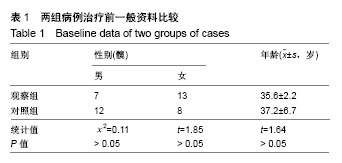| [1] Persiani P,De Cristo C,Graci J,et al.Stage-related results in treatment of hip osteonecrosis with core-decompression and autologous mesenchymal stem cells.Acta Orthop Belg. 2015; 81(3):406-412. [2] Woodhouse AG,Drake ML,Lee GC,et al.Free vascularized fibular grafts for femoral head osteonecrosis:alternative technique utilizing a buttress plate for graft fixation.J Surg Orthop Adv.2015;24(2):144-146.[3] Liu ZH,Guo WS,Li ZR,et al.Porous Tantalum rods for treating osteonecrosis of the femoral head.Genet Mol Res. 2014;13(4): 8342-8352.[4] Shah SN,Kapoor CS,Jhaveri MR,et al.Analysis of outcome of avascular necrosis of femoral head treated by core decompression and bone grafting.J Clin Orthop Trauma. 2015;6(3):160-166.[5] 胡彤宇,扈文海,李建衡,等.髓芯减压BMP植入治疗股骨头坏死的血流量及病理改变[J].中国矫形外科杂志, 2002,9(4):370-373.[6] 杨建平,王黎明,徐燕,等.多孔髓芯减压联合干细胞移植治疗股骨头坏死的早期随访结果[J].中国组织工程研究与临床康复, 2007, 11(20):3936-3939.[7] 杨新明,石蔚,杜雅坤,等.非细胞型组织工程骨联合钛棒微创植入治疗股骨头早期坏死的疗效分析[J].中华骨科杂志, 2010,30(1): 53-57.[8] 杨新明,石蔚,杜雅坤,等.关节镜辅助下髓芯减压植入复合自体骨髓的骨诱导材料联合钛棒支撑治疗Ⅱ期股骨头坏死[J].中华临床医师杂志(电子版),2010,4(5):622-629.[9] 王立强,高建国,刘思源.酒精性股骨头坏死与血凝因素的关系研究[J].河北医科大学学报,2015,36(4):467-469.[10] Miao H,Ye D,Liang W,et al.Effect of Osteonecrosis Intervention Rod Versus Core Decompression Using Multiple Small Drill Holes on Early Stages of Necrosis of the Femoral Head:A Prospective Study on a Series of 60 Patients with a Minimum 1-Year-Follow-Up.Open Orthop J.2015:9:179-184.[11] Zhang X,Wang J,Xiao J,et al.Early failures of porous Tantalum osteoneerosis implants:a case series with retrieval analysis.Int Orthop.2016;40(9):1827-1834.[12] Yang XM,Shi W,Du YK,et al.Arthroscopy Assisted Lesion Clearance and Bone Graft, Titanium Rod Support Treatment of Early Stage Osteonecrosis of the Femoral Head of the Postoperative Survival Rate Analysis.Surg Sci. 2017;8(1): 37-46.[13] 杨新明,石蔚,杜雅坤,等.关节镜辅助下病灶清除、植骨、钛棒支撑治疗股骨头早期坏死术后生存率分析[J].中华骨与关节外科杂志,2016,9(5):394-397.[14] 刘蜀君,余美春,袁恭贵,等.关节镜辅助下髓芯减压植入复合自体骨髓的骨诱导材料联合钛棒支撑治疗Ⅱ期股骨头坏死[J].健康前沿,2016,23(2):198.[15] Koren L,Ginesin E,Melamed Y,et al.Hyperbaric oxygen for stage I and II femoral head osteonecrosis. Orthopedics. 2015; 38(3):e200-e205.[16] Franceschi F,Franceschetti E,Paciotti M,et al.Surgical management of osteonecrosis of the humeral head:a systematic reviewp.Knee Surg Sports Traumatol Arthrosc. 2016.[Epub ahead of print].[17] Samy AM.Management of osteonecrosis of the femoral head:a novel technique.Indian J Orthop.2016;50(4):359-365.[18] 赵德伟,程亮亮.国内股骨头坏死保留髋关节手术治疗的十年回顾[J].中华骨科杂志,2017,37(3):183-192.[19] 中华老年骨科与康复电子杂志编辑委员会.股骨头坏死保髋治疗指南(2016版)[J].中华老年骨科与康复电子杂志, 2016,2(2): 65-70.[20] 杨元庆,王思群,魏亦兵,等.早期股骨头坏死保头手术治疗进展[J].复旦学报(医学版),2017,44(1):117-121.[21] 叶奕亨,陈凯,金可可,等.塌陷前期股骨头坏死的保头手术治疗的进展[J].中国骨伤,2017,30(3):287-292.[22] Wang CJ,Huang CC,Wang JW,et al.Long-term results of extra-corporeal shockwave therapy and core decompression in osteonecrosis of the femoral head with eight-to nine-year follow-upBiomed J.2012;35(6):481-485.[23] Beckmann J,Schmidt T,Schaumburger J,et al.Infusion,core decompression, or infusion following core decompression in the treatment of bone edema syndrome and early avascular osteonecrosis of the femoral head.Rheumatol Int. 2013;33(6): 1561-1565.[24] Zhao DW,Yu XB.Core decompression treatment of early-stage osteonecrosis of femoral head resulted from venous stasis or artery blood supply insufficiency.J Surg Res. 2015;194(2):614-621.[25] Jiang JJ,Hussain WM,Bielski RJ.Bone impaction grafting of the lateral femoral condyle in a pediatric patient.Orthopedics. 2012;35(10):e1533-1536.[26] Daltro GC,Fortuna V,de Souza ES,et al.Efficacy of autologous stem cell-based therapy for osteonecrosis of the femoral head in sickle cell disease:a five-year follow-up study.Stem Cell Res Ther. 2015;6:110.[27] Roth A,Beckmann J,Smolenski U,et al.S3 guideline. Part 2: non-traumatic avascular femoral head necrosis in adults- untreated course and conservative treatment.Z Orthop Unfall. 2015;153(5):488-497. [28] 汪亮,刘耀升,刘蜀彬,等.多孔钽棒植入治疗早中期股骨头坏死的生存率分析和预后因素评估[J].中华骨与关节外科杂志, 2015, 26(5):396-402.[29] 吴刚,张永锋.复合自体骨髓的骨诱导材料结合髓芯减压钛棒支撑修复Ⅱ期股骨头坏死[J].中国组织工程研究, 2015,19(28): 4460-4464.[30] Fontecha CG,Roca I,Barber I,et al.Femoral head bone viability after free vascularized fibular grafting for osteonecrosis: SPECT/CT study.Microsurgery. 2016;36(7): 573-577.[31] Pierce TP,Jauregui JJ,Elmallah RK,et al.A current review of core decompression in the treatment of osteonecrosis of the femoral head.Curr Rev Musculoskelet Med. 2015;8(3):228-232.[32] Millikan PD,Karas V,Wellman SS.Treatment of osteonecrosis of the femoral head with vascularized bone grafting.Curr Rev Musculoskelet Med.2015;8(3):252-259.[33] 毛子木,尹崑,王宇泽,等.多孔钽金属置入治疗早期股骨头坏死的研究与应用现状[J].中国组织工程研究, 2016,20(43):6479-6486.[34] 刘玮璐,张洋,张贤祚,等.多孔钽金属棒治疗股骨头坏死的最新研究进展[J].中华关节外科杂志:电子版,2017,11(2):62-65.[35] 何小强,廖军义,陈宇,等.国产多孔钽棒治疗早期股骨头缺血性坏死的临床疗效[J].中华创伤杂志,2017,33(6):521-526.[36] 陈卫衡,谢斌,刘道兵,等.髓芯减压植骨术治疗股骨头坏死临床疗效的动态研究[J].中华关节外科杂志,2014,8(5):578-584.[37] 杨富强,杨晓明,葛建健,等.髓芯减压植骨联合富血小板血浆治疗股骨头缺血性坏死的前瞻随机对照研究[J].中华关节外科杂志:电子版,2016,10(2):140-144.[38] 张晨,张二洋,李苗,等.髓芯减压联合纳米骨植入治疗早期股骨头坏死的近期疗效[J].山西医科大学学报,2016,47(6):565-569[39] Ma Y,Wang T,Liao J,et al.Efficacy of autologous bone marrow buffy coat grafting combined with core decompression in patients with avascular necrosis of femoral head: a prospective, double-blinded, randomized, controlled study. Stem Cell Res Ther.2014;5(5):115. [40] 李钧,童哲,魏勇,等.miR-125 b靶向Smad4调控非创伤性股骨头坏死骨髓基质干细胞成骨分化与增殖的相关性[J].中国老年学杂志,2017,37(2):306-308. [41] 高宏阳,李晓明,王健,等.新型纳米髓芯减压棒联合脐带间充质干细胞移植治疗早期股骨头坏死的临床疗效[J].江苏医药, 2015, 41(24):3016-3017. |
.jpg)




.jpg)
.jpg)